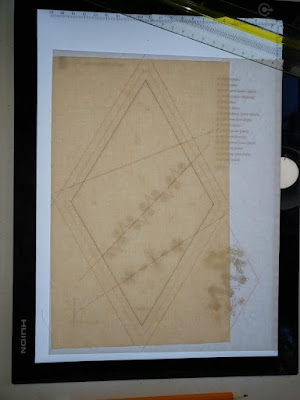
“Have you ever wanted to create a crazy
quilt, but were worried over how to start? Well, that’s exactly why I wrote
Dazzling Diamonds. The intent was to give readers a full instruction book,
using modern techniques, to enable them to create a crazy quilt from
start-to-finish. I purposely used cotton fabrics because quilters and
seamstress/tailors already were familiar with that type of fabric. I also made
the decision to keep the project small so it was manageable in size so to not
become too over-whelming. This is what I call a “planned project” because the
quilt is totally designed for you. The layout, the individual embellishing
design, and the specific embroidery stitches have all been provided to ensure a
balanced final project. Success is practically guaranteed if you just follow
the path laid out before you. The Sew-A-Long will also give you a venue to ask
questions (just post a comment here on my blog).
Silks, satins, velvets make gorgeous
quilts. But, they are not easy fabrics to work with, especially when you are at
the basic stage of creating a crazy quilt. Plus, these fancy fabrics can be
very expensive to source. We don’t want to waste our precious fancy fabrics as
we learn the principles needed to create this multi-faceted quilt. Rather,
let’s make sure to guarantee our success by using good quality cotton.
These blocks will be packed full of
beautiful embroidery work, silk ribbon flowers, and beads/baubles. This gives
the reader the full spectrum of techniques they will need to learn. The end
result is a beautiful wall hanging. PLUS you will have gained the confidence to
try a larger quilt…which could also incorporate those lush velvets, satins,
silks and brocades we all dream about when thinking of traditional crazy
quilts.
Cotton does not have to be boring! So, don’t
be concerned that we are not using velvets or silks. This is after all, a
“learning” endeavor. Plus, there are some gorgeous batiks and cotton
tone-on-tone blenders on the market today. We will be using a wonderful set of
rich autumn colors in the sample quilt for this Sew-A-Long. But, you can select
the palette of your own desire…maybe a spring color set (like the book cover
shows); or go with a lovely monochromatic grouping even. If you would like to
use the same fabrics as I’ll be using…then hop on over to Connecting Threads
(details below).”
How the
Sew-A-Long Works
The Crazy Quilting Dazzling Diamonds will be
released in 3 main parts and will be available on the C&T Blog as well as my personal blog following
the schedule below. With each part, you will receive instructions to follow
along as I recreate the Dazzling
Diamonds Quilt from my book, Crazy
Quilting Dazzling Diamonds. I will show you my progress and give you
helpful tips and tricks in each part. There will be also be additional blog posts here on my blog; just to provide individual close-up photos and give you
extra information as the Sew-A-Long progresses. While the book will be the path
for this quilt, I will also share different piecing options and design
principles you would need when venturing into a quilt that is not already
“planned out” for you.
Schedule
Tuesday,
October 10: Dazzling Diamonds Sew-A-Long announcement
(You are here!)(I'm a day late however)
Friday,
October 20: Part 1- Organization, Design Principles,
Piecing the Blocks
Friday,
October 27: Part 2- Embroidery Design Transfer, Base
Seams
Friday,
November 3: Part 3-Silk Ribbon Flowers, Beads &
Baubles, Finishing
What
you’ll need
Here are the links to the exact fabric that I will be using in the Sew-A-Long:
Autumn Sunset Batiks Fat Quarter Sampler |
ConnectingThreads.com
Agate Batik | ConnectingThreads.com
Labyrinth Batik | ConnectingThreads.com
To get you prepared for the Dazzling Diamonds
Sew-A-Long, here is a list of materials and project notes. In addition to
standard sewing and quilt-making supplies, you’ll need:
A physical or ebook copy of Crazy Quilting
Dazzling Diamonds.
SUPPLIES:
Fabrics
Variety
of small prints, solids, and nondirectional blenders in light/medium values:
1/4 yard or fat eighth each for blocks
Border
fabric: 3/4 yard of medium-weight cotton upholstery
fabric
Foundation
fabric: 2 yards of neutral-color cotton broadcloth or
good-quality muslin
Backing
and hanging sleeve: 11/8 yards
Other
Materials
Water-soluble
printable stitch stabilizer sheets or Embroidery Shape Templates (See Online Resources, page 94.)
Template
plastic
Perle
cotton: Size 8 in a variety of colors or 3-ply six
strand embroidery fibers
Silk
ribbon: Sizes 2 mm, 4 mm, 7 mm, and 13 mm in assorted
flower and leaf colors (sizes can be adjusted but 4mm & 7mm is critical)
Seed
beads: Size 11 (standard) (can also use size 15/20)
Round
beads: Sizes 2 mm, 3 mm, and 4 mm in glass, crystal,
or plastic as you like
Crystal
montées: Sizes 3 mm and 4 mm or small
Sequins: Sizes 4 mm, 6 mm, 8 mm, and 10 mm
Floral
beads caps: Sizes 6 mm–10 mm
Flat
2-hole and 4-hole buttons: 1/4 ̋–1/2 ̋ in diameter
Note: The selection of fibers, beads &
baubles are personal and will depend on your own stash and the color you
choose. All of the above types can be substituted with any other “bauble” you
like, just keep to the same general size to ensure the final result remains
balanced. Half the fun of embellishing is getting to use that “favorite” bead,
sequin, button or jewelry finding!
Connect
with us!
Follow C&T’s Facebook
and Instagram
pages for weekly reminders! You are invited to share your progress by tagging
@ctpublishing and using #DazzlingDiamondsSewALong. But, if you have any questions,
reach out to me here on my blog as I'm always happy to answer any questions you might have.















